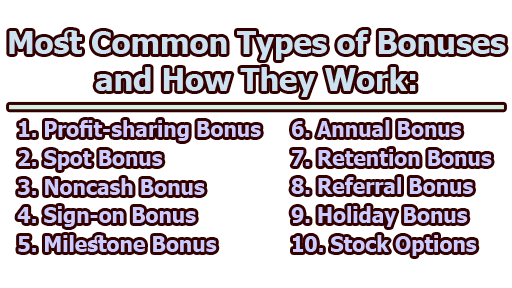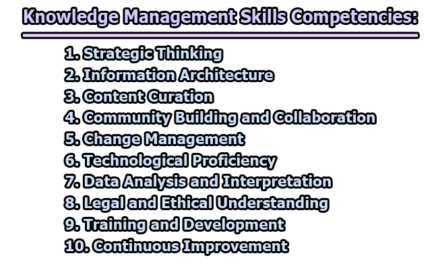Most Common Types of Bonuses and How They Work:
In today’s competitive business landscape, companies often use various types of bonuses as a strategic tool to attract and retain talented employees, motivate their workforce, and reward exceptional performance. Bonuses can take various forms and are designed to incentivize employees for their efforts, accomplishments, and loyalty. In this article, we will explore the most common types of bonuses and how they work to enhance employee engagement and overall organizational success.
1. Profit-sharing Bonus: Profit-sharing bonuses are directly tied to a company’s financial success. When the company performs well and generates profits, a portion of those profits is distributed among employees. The distribution formula can be based on factors such as individual performance, tenure, or a percentage of the employee’s salary. Profit-sharing fosters a sense of ownership and teamwork, as employees understand that their efforts directly impact their rewards. It also aligns the interests of employees with the company’s long-term success.
2. Spot Bonus: Spot bonuses are spontaneous rewards given to employees for exceptional efforts or achievements that go above and beyond their regular responsibilities. Unlike other bonuses with predetermined schedules, spot bonuses are typically discretionary and are granted on an ad-hoc basis. This immediate recognition reinforces positive behaviors and motivates employees to continue excelling in their roles.
3. Noncash Bonus: Noncash bonuses offer employees rewards other than traditional monetary compensation. These rewards can include gift cards, travel vouchers, paid vacations, merchandise, or even additional time off. Noncash bonuses allow employers to offer more personalized rewards, catering to the individual preferences and interests of employees. They can be particularly valuable for enhancing work-life balance and promoting employee well-being.
4. Sign-on Bonus: Sign-on bonuses are offered to new hires as an incentive to join the company. They are particularly common in industries where there is high demand for specialized skills and talent. Sign-on bonuses can be a one-time lump sum or spread out over several payments, helping the new employee transition smoothly into their new role and aligning their interests with the company’s success.
5. Milestone Bonus: Milestone bonuses reward employees for achieving specific performance milestones or goals. These goals can be tied to individual accomplishments, team projects, or company-wide targets. Milestone bonuses provide employees with clear objectives to strive for, fostering a sense of progress and achievement. They also help keep employees focused on their professional development and contribute to a culture of continuous improvement.
6. Annual Bonus: Annual bonuses are a common type of bonus given at the end of the year based on overall performance or the achievement of annual targets. These bonuses can be calculated using a formula that considers various performance metrics, such as individual goals, team accomplishments, and company profits. Annual bonuses provide employees with a tangible reward for their efforts throughout the year and can have a significant impact on morale and motivation.
7. Retention Bonus: Retention bonuses are used to encourage employees to stay with the company for a specific period, especially during times of uncertainty or organizational change. These bonuses are often offered to key employees or those with critical skills and expertise. By incentivizing employee retention, companies can reduce turnover and maintain stability during challenging times.
8. Referral Bonus: Referral bonuses are incentives provided to employees for referring qualified candidates for open positions within the company. These bonuses serve as a cost-effective way to attract top talent through employee networks. Employees are motivated to recommend candidates they believe would be a good fit for the company, as they can benefit from the successful onboarding of the referred individual.
9. Holiday Bonus: Holiday bonuses are given to employees during festive seasons or special occasions as a gesture of appreciation and to celebrate the spirit of the holidays. These bonuses can vary in size and are typically seen as a token of gratitude for the dedication and hard work displayed by employees throughout the year. Holiday bonuses can contribute to a positive work atmosphere and boost employee morale during the holiday season.
10. Stock Options: Stock options provide employees with the opportunity to purchase the company’s stock at a predetermined price, typically known as the exercise price or strike price. Employees are granted these options as part of their compensation package and are usually subject to a vesting period, during which the options cannot be exercised. Stock options align the interests of employees with the long-term success of the company, as they benefit directly from any increase in the stock price.
It is apparent that bonuses play a vital role in employee motivation, satisfaction, and overall company success. Each type of bonus serves a unique purpose, ranging from immediate recognition through spot bonuses to long-term alignment with the company’s financial performance through profit-sharing and stock options. By strategically implementing a combination of these bonus types, companies can foster a culture of excellence, retain top talent, and create a motivated and engaged workforce ready to drive the organization forward. Additionally, a well-designed bonus program showcases the company’s commitment to valuing its employees and investing in their growth and development.
Frequently Asked Questions [FAQs]:
What is a profit-sharing bonus, and how does it work?
A profit-sharing bonus is a form of incentive compensation where employees receive a portion of the company’s profits. The distribution of the bonus is usually based on predetermined factors, such as individual performance, team contributions, or company-wide results. The idea is to align employees’ interests with the company’s success, as they directly benefit from its profitability.
How do spot bonuses differ from other types of bonuses?
Spot bonuses are unique because they are given spontaneously and not based on a fixed schedule. Unlike annual or milestone bonuses, spot bonuses are granted as immediate recognition for outstanding performance or going above and beyond in their roles. Spot bonuses are often used to reinforce positive behaviors and motivate employees in real time.
What are noncash bonuses, and why are they popular?
Noncash bonuses are rewards given to employees in forms other than traditional monetary compensation. These can include gift cards, travel vouchers, paid vacations, merchandise, or additional time off. Noncash bonuses are popular because they offer more personalized rewards that cater to individual preferences and help promote work-life balance and well-being.
What is a sign-on bonus, and when is it typically offered?
A sign-on bonus is an incentive given to new employees when they join a company. It is often offered in industries where there is high demand for specialized skills or talent. The sign-on bonus helps attract top candidates and facilitates their transition to the new role, as it can offset costs associated with changing jobs.
How do milestone bonuses contribute to employee development?
Milestone bonuses are designed to reward employees for achieving specific goals or milestones. These can be related to individual accomplishments, team projects, or company-wide objectives. Milestone bonuses provide employees with clear targets to strive for, fostering a sense of progress and continuous improvement in their roles.
Are annual bonuses common, and how are they calculated?
Yes, annual bonuses are prevalent in many organizations. The calculation of annual bonuses varies, but it often considers factors such as individual performance, team achievements, and the overall financial performance of the company during the year. The bonus amount may be a percentage of the employee’s salary or a fixed sum based on achievement levels.
What is a retention bonus, and when is it typically offered?
A retention bonus is given to employees to encourage them to stay with the company for a specific period, particularly during times of organizational change or uncertainty. It is often offered to key employees or those with critical skills and expertise to ensure stability and continuity.
How do referral bonuses benefit both employees and companies?
Referral bonuses incentivize employees to refer qualified candidates for open positions within the company. This benefits both parties; employees can earn rewards for successful referrals, and companies gain access to potential talent through their employees’ networks, saving on recruitment costs.
How do holiday bonuses contribute to employee morale?
Holiday bonuses are given during festive seasons or special occasions as a gesture of appreciation. They help boost employee morale, create a positive work atmosphere, and show gratitude for the dedication and hard work displayed by employees throughout the year.
What are stock options, and how do they align with employee interests?
Stock options provide employees with the option to purchase the company’s stock at a predetermined price. The stock options are usually subject to a vesting period, encouraging employees to stay with the company to fully benefit from any potential increase in the stock price. This aligns employees’ interests with the company’s long-term success and can be a powerful tool for retaining and motivating talent.

Former Student at Rajshahi University










